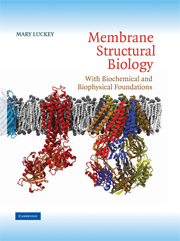Book contents
- Frontmatter
- Contents
- Preface
- 1 Introduction
- 2 The Diversity of Membrane Lipids
- 3 Tools for Studying Membrane Components: Detergents and Model Systems
- 4 Proteins in or at the Bilayer
- 5 Bundles and Barrels
- 6 Functions and Families
- 7 Protein Folding and Biogenesis
- 8 Diffraction and Simulation
- 9 Membrane Enzymes and Transducers
- 10 Transporters and Channels
- 11 Membrane Protein Assemblies
- 12 Themes and Future Directions
- Appendix I Abbreviations
- Appendix II Single-Letter Codes for Amino Acids
- Index
- References
11 - Membrane Protein Assemblies
- Frontmatter
- Contents
- Preface
- 1 Introduction
- 2 The Diversity of Membrane Lipids
- 3 Tools for Studying Membrane Components: Detergents and Model Systems
- 4 Proteins in or at the Bilayer
- 5 Bundles and Barrels
- 6 Functions and Families
- 7 Protein Folding and Biogenesis
- 8 Diffraction and Simulation
- 9 Membrane Enzymes and Transducers
- 10 Transporters and Channels
- 11 Membrane Protein Assemblies
- 12 Themes and Future Directions
- Appendix I Abbreviations
- Appendix II Single-Letter Codes for Amino Acids
- Index
- References
Summary
Most of the membrane proteins described in the previous chapters can carry out their tasks without partners, although some form homo-oligomers and others are involved in transient interactions, for example, with signaling proteins. Because they can function on their own, their high-resolution structures reveal a great deal about their mechanisms. In contrast, many membrane proteins function in large complexes and can be understood only when the other protein components in these multiprotein assemblies are characterized as well. This chapter describes structures of some multicomponent complexes that can be viewed as molecular machines, or nanomachines, in the membrane. These vary from large enzymes composed of many subunits, such as ATP synthase, to dimers of protomers that each have many subunits, such as cytochrome-bc1 oxidase, to structures formed when separate proteins interact, sometimes across more than one membrane as seen in the proteins involved in drug efflux in Gram-negative bacteria (Frontispiece).
F1F0-ATPase/ATP SYNTHASE
Familiar for decades for its knob-on-a-stalk appearance, the F1F0-ATPase is named for its two major structural domains, F1 and F0 (Figure 11.1). This fascinating complex is also called the ATP synthase because it couples the flow of protons across the membrane to the synthesis of ATP as well as its hydrolysis, depending on the direction of proton flux. Found in the plasma membrane of bacteria, the mitochondrial inner membrane in eukaryotes, and the chloroplast thylakoid membrane in plants, the ATP synthase is the major producer of ATP in cells using either oxidative phosphorylation or photosynthesis to generate a proton motive force (pmf, the proton electrochemical gradient across the membrane that stores energy).
- Type
- Chapter
- Information
- Membrane Structural BiologyWith Biochemical and Biophysical Foundations, pp. 271 - 308Publisher: Cambridge University PressPrint publication year: 2008



